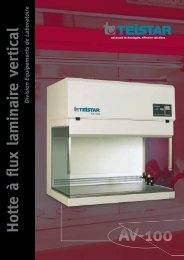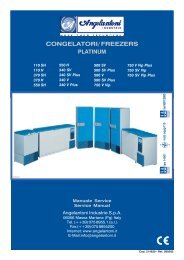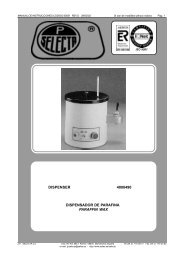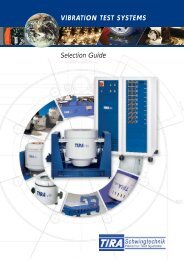Serial Communications Protocol Specifications - Swissvacuum.com
Serial Communications Protocol Specifications - Swissvacuum.com
Serial Communications Protocol Specifications - Swissvacuum.com
Create successful ePaper yourself
Turn your PDF publications into a flip-book with our unique Google optimized e-Paper software.
INTRODUCTION<br />
- 4 -<br />
The present document contains information on the Modbus protocol for performing data exchange between a PC and<br />
the MicroPLC chamber controller. You can find here a short description of the query and answer sintax for the<br />
Modbus function 3 (read function) and function 16 (write function).<br />
Moreover, a short example of code has been included as a guideline for the development of a <strong>com</strong>plete program.<br />
A <strong>com</strong>munication protocol defines media, data formats and rules which are <strong>com</strong>mon to two or more systems wich<br />
must exchange informations by means of a phisical <strong>com</strong>munication line.<br />
Moreover is described here how the devices (master and salve) connected to the line interact between them to start<br />
and close the <strong>com</strong>munication, and the way to identify error conditons during the data transmission.<br />
Pratically the protocol allows a data exchange between Master device and a Slave device according to the following<br />
situation:<br />
Fig. 1 Master and Slave<br />
PC as MASTER CHAMBER CONTROLLER as SLAVE<br />
SLAVE ADDRESS<br />
FUNCTION CODE<br />
DATA<br />
ERROR CHECK<br />
SLAVE ADDRESS<br />
FUNCTION CODE<br />
DATA<br />
ERROR CHECK<br />
In this architecture, PC always acts as Master while the chamber controller is always the Slave device.<br />
The Master device is the only one that can start the <strong>com</strong>munication.<br />
The <strong>com</strong>munication consists essentially in a query made by the Master device (normally a PC) that is directly<br />
followed by an answer <strong>com</strong>ing from the Slave device (the MicroPLC chamber controller).<br />
The <strong>com</strong>munication task, either is a query or an answer, consists in preparing a data packet wich includes the<br />
identification code of the requested function, the lenght of the query/answer, the data itself and error check<br />
information. This data packet is then transmitted to the device on the other end of the serial <strong>com</strong>munication line.<br />
Thus the Modbus protocol defines the structure of the data packet in wich the relevant information to be exchanged<br />
are encapsulated. The fields consituting the data packet are: destination address, function code of the action to be<br />
performed, the relevant data for the operation and an error verification code.<br />
When a Slave device receives a data packet, it decodes the data and execute the operation that the Master device<br />
has required (operation that can be reading or writing data in the Slave device memory).<br />
At this point the Slave device create the needed data packet and “returns it to sender”. The information in the<br />
response message is the slave device address, the action performed, the data acquired as a result of the action and a<br />
mean of checking errors.<br />
<strong>Serial</strong> <strong>com</strong>munications protocol vers. 2.02 Angelantoni Industrie Spa Massa Martana (PG) Italy






